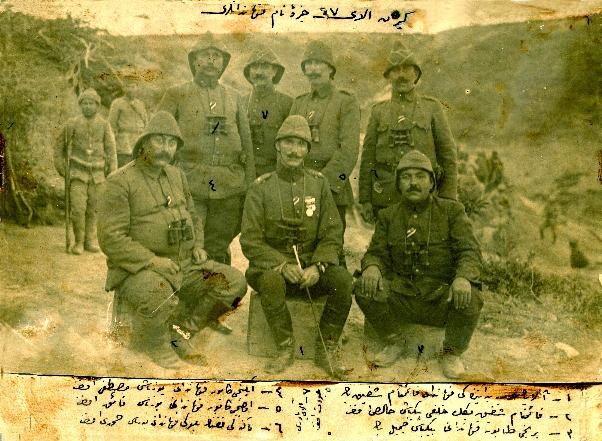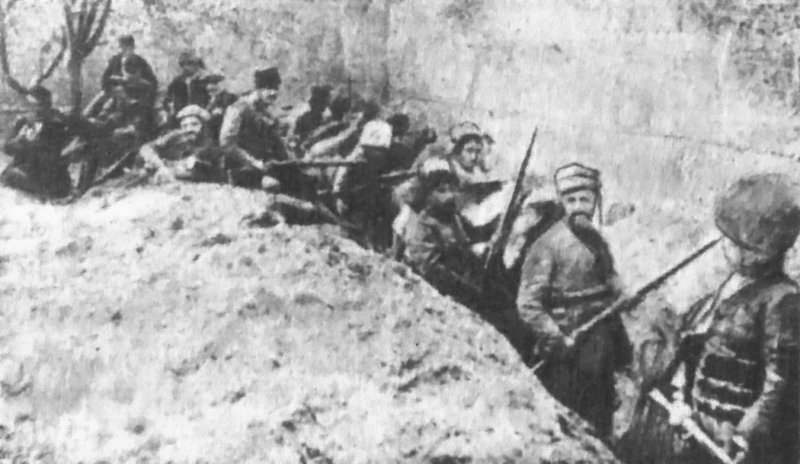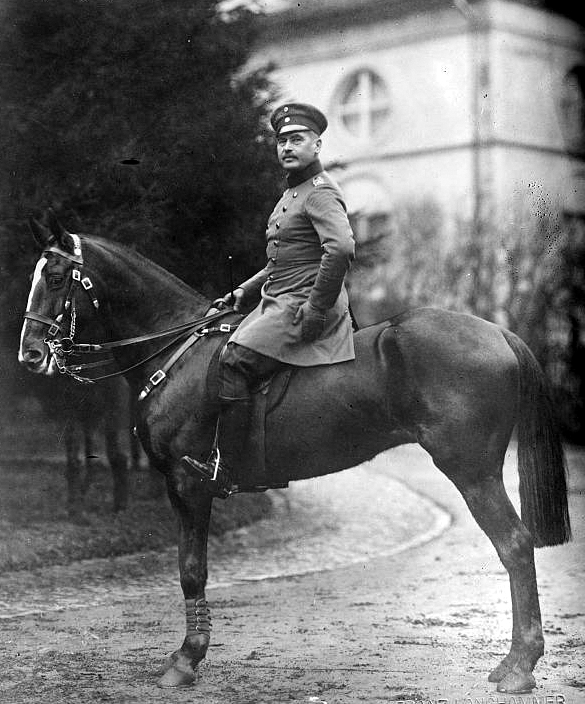|
27th Infantry Regiment (Ottoman Empire)
The 27th Infantry Regiment ( Turkish: or ) or simply 27th Regiment (Turkish: or ) was a regiment of the Ottoman Army during World War I. It is best known for its response to the landing at Anzac Cove of Australian and New Zealand forces on 25 April 1915 during the Gallipoli campaign. History The date of the regiment's formation is unknown. World War I At the start of World War I the regiment was assigned to the 9th Division. In September 1914 the 27th Regiment and the 9th Division relocated to the Gallipoli Peninsula. Following the appointment of Lieutenant Colonel Irfan to command the Menderes Detachment on 10 November 1914 Kolağası (Major) Mehmed Şefik was appointed to replace him as commander of the 27th Regiment of the 9th division. On 29 November 1914 Şefik was promoted to the rank of Binbaşı (Lieutenant Colonel). While its officers were from various parts of the Ottoman Empire most of the conscripts and NCOs of the 27th Regiment came from the Gallipoli Penins ... [...More Info...] [...Related Items...] OR: [Wikipedia] [Google] [Baidu] |
Ottoman Empire
The Ottoman Empire, * ; is an archaic version. The definite article forms and were synonymous * and el, Оθωμανική Αυτοκρατορία, Othōmanikē Avtokratoria, label=none * info page on book at Martin Luther University) // CITED: p. 36 (PDF p. 38/338) also known as the Turkish Empire, was an empire that controlled much of Southeast Europe, Western Asia, and Northern Africa between the 14th and early 20th centuries. It was founded at the end of the 13th century in northwestern Anatolia in the town of Söğüt (modern-day Bilecik Province) by the Turkoman tribal leader Osman I. After 1354, the Ottomans crossed into Europe and, with the conquest of the Balkans, the Ottoman beylik was transformed into a transcontinental empire. The Ottomans ended the Byzantine Empire with the conquest of Constantinople in 1453 by Mehmed the Conqueror. Under the reign of Suleiman the Magnificent, the Ottoman Empire marked the peak of its power and prosperity, as well a ... [...More Info...] [...Related Items...] OR: [Wikipedia] [Google] [Baidu] |
Binbaşı
A ''binbashi'', alternatively ''bimbashi'', (from tr, Binbaşı, "chief of a thousand", "chiliarch") is a major in the Turkish army, of which term originated in the Ottoman army. The title was also used for a major in the Khedivial Egyptian army as ''Bimbashi'' (1805–1953). It was also used by the Serbian revolutionaries as ''Bimbaša'' ( sr-cyr, Бимбаша) in 1804–1817. Since the restructuring of the modern Turkish Army in 1934, ''Binbaşı'' means major; but in the Ottoman Army (and in the pre-1934 Turkish Army, during the early years of the Turkish Republic) the more correct equivalent of the Western rank "major" was '' Kolağası'' (senior captain), which ranked above ''Yüzbaşı'' ( captain) and below ''Binbaşı''. When the rank '' Kolağası'' was removed from the Turkish Army in 1934, the rank ''Binbaşı'' was relegated to major (before 1934, the rank ''Binbaşı'' was also considered an equivalent of lieutenant colonel.) Until 1934, it was the duty of a ... [...More Info...] [...Related Items...] OR: [Wikipedia] [Google] [Baidu] |
Caucasus Campaign
The Caucasus campaign comprised armed conflicts between the Russian Empire and the Ottoman Empire, later including Armenia, Azerbaijan, Georgia, the Mountainous Republic of the Northern Caucasus, the German Empire, the Central Caspian Dictatorship, and the British Empire, as part of the Middle Eastern theatre during World War I. The Caucasus campaign extended from the South Caucasus to the Armenian Highlands region, reaching as far as Trabzon, Bitlis, Mush and Van. The land warfare was accompanied by naval engagements in the Black Sea. The Russian military campaign started on 1 November 1914 with the Russian invasion of Turkish Armenia. In February 1917, the Russian advance was halted following the Russian Revolution. The Russian Caucasus Army soon disintegrated and was replaced by the forces of the newly established Armenian state, comprising Armenian volunteer units and irregular units which had previously been part of the Russian Army. During 1918 the region also s ... [...More Info...] [...Related Items...] OR: [Wikipedia] [Google] [Baidu] |
19th Infantry Division (Ottoman Empire)
The 19th Infantry Division was a formation of the Ottoman Army, during the Balkan Wars and the First World War. Two thirds of the division was made up of Syrian Arabs, who faced the first wave of the Allied invasion during the Gallipoli campaign, and one third were Turks. Formation :Commander: Lieutenant Colonel Mustafa Kemal Mustafa ( ar, مصطفى , Muṣṭafā) is one of the names of Prophet Muhammad, and the name means "chosen, selected, appointed, preferred", used as an Arabic given name and surname. Mustafa is a common name in the Muslim world. Given name ... * 57th Regiment: Major Hüseyin Avni **1st Battalion Captain Ahmet Zeki **2nd Battalion Captain Ata **3rd Battalion Captain Hayri *72nd Regiment: Major Mehmet Münir *77th Regiment: Major Saip *39th Artillery Regiment: Major Halil Galib (Tekaki) The 18th and 27th Regiments were also assigned to the division later in the Gallipoli campaign. References Military units and formations of the Ottoman Empire i ... [...More Info...] [...Related Items...] OR: [Wikipedia] [Google] [Baidu] |
Eceabat
Eceabat, formerly Maydos (Madytos, el, Μάδυτος), is a small town and district of Çanakkale province in the Marmara region of Turkey, located on the eastern shore of the Gelibolu Peninsula, on the Dardanelles Strait. According to the 2010 census, the local population is 9,154 of whom 5,380 live in the town of Eceabat. The district covers an area of , and the town lies at sea level. It is an almost entirely modern town. Eceabat is the departure point for the annual swim across the Hellespont to Çanakkale on the other side of the Dardanelles Strait. Eceabat is the nearest town to the World War I Gallipoli Campaign battlefield sites, as well as to the cemeteries and memorials to the more than 120,000 Turkish, British, French, Australia ad New Zealand soldiers killed during the campaign. This has led to its becoming a major tourism centre, especially around 18 March and 15 April ( ANZAC Day) when the two different sides of the struggle commemorate their roles in what happe ... [...More Info...] [...Related Items...] OR: [Wikipedia] [Google] [Baidu] |
Surname Law
Surname law can refer to any law regulating the use of surnames. Canada From 1941 to 1978, the Government of Canada issued disc numbers to identify Inuit in their records. In the mid-1960s Project Surname began, and, headed by Abe Okpik, Inuit were given surnames in a similar manner to how surnames were used among Canadians of European descent. Iceland Icelandic law enforces the conventions of Icelandic names, which require that the last name be derived from a given name of the father or mother, suffixed with "-son" or "-dóttir". The law allows both derivations to be used, and for foreign last names to be inherited or kept by foreigners. This means that a father, mother, and child will all typically have different last names. Foreigners who marry an Icelander and get Icelandic citizenship can take the last name of their partner, or a patronym or matronym from the name of a parent or parent-in-law; these possibilities are not necessarily open to native Icelanders. Iran Re ... [...More Info...] [...Related Items...] OR: [Wikipedia] [Google] [Baidu] |
Italo-Turkish War
The Italo-Turkish or Turco-Italian War ( tr, Trablusgarp Savaşı, "Tripolitanian War", it, Guerra di Libia, "War of Libya") was fought between the Kingdom of Italy and the Ottoman Empire from 29 September 1911, to 18 October 1912. As a result of this conflict, Italy captured the Ottoman Tripolitania Vilayet, of which the main sub-provinces were Fezzan, Cyrenaica, and Tripoli itself. These territories became the colonies of Italian Tripolitania and Cyrenaica, which would later merge into Italian Libya. During the conflict, Italian forces also occupied the Dodecanese islands in the Aegean Sea. Italy agreed to return the Dodecanese to the Ottoman Empire in the Treaty of Ouchy in 1912. However, the vagueness of the text, combined with subsequent adverse events unfavourable to the Ottoman Empire (the outbreak of the Balkan Wars and World War I), allowed a provisional Italian administration of the islands, and Turkey eventually renounced all claims on these islands in Article ... [...More Info...] [...Related Items...] OR: [Wikipedia] [Google] [Baidu] |
Mustafa Kemal Atatürk
Mustafa Kemal Atatürk, or Mustafa Kemal Pasha until 1921, and Ghazi Mustafa Kemal from 1921 Surname Law (Turkey), until 1934 ( 1881 – 10 November 1938) was a Turkish Mareşal (Turkey), field marshal, Turkish National Movement, revolutionary statesman, author, and the founding father of the Republic of Turkey, serving as its first President of Turkey, president from 1923 until Death and state funeral of Mustafa Kemal Atatürk, his death in 1938. He undertook sweeping progressive Atatürk's reforms, reforms, which modernized Turkey into a secular, industrializing nation.Harold Courtenay Armstrong Gray Wolf, Mustafa Kemal: An Intimate Study of a Dictator. page 225 Ideologically a Secularism, secularist and Turkish nationalism, nationalist, Atatürk's Reforms, his policies and socio-political theories became known as Kemalism. Due to his military and political accomplishments, Atatürk is regarded as one of the most important political leaders of the 20th century. Ata ... [...More Info...] [...Related Items...] OR: [Wikipedia] [Google] [Baidu] |
Otto Liman Von Sanders
Otto Viktor Karl Liman von Sanders (; 17 February 1855 – 22 August 1929) was an Imperial German Army general who served as a military adviser to the Ottoman Army during the First World War. In 1918 he commanded an Ottoman army during the Sinai and Palestine Campaign. On the whole Sanders provided only limited help to the Ottoman forces. Early life and career Otto Liman was born in Stolp (now Słupsk, Poland) in the Province of Pomerania in the Kingdom of Prussia. He was the son of Carl Leonhard Liman and his wife Emma née Michaelis. Carl Liman was a prosperous businessman, who purchased the lordship of the manor (Rittergut) of Schwessin (now Świeszyno, Poland). Although divergent details of Carl Liman's paternal ancestry are recorded, it is generally agreed that his father and Otto's grandfather was born to a Jewish family by the name of Liepmann and was later baptised a Christian. After gaining his diploma (Abitur) at the Friedrich Wilhelm Gymnasium in Berlin, Otto Lima ... [...More Info...] [...Related Items...] OR: [Wikipedia] [Google] [Baidu] |
Kol Aghassi
''Kolağası'' (also written as ''Kol Ağası'', ''Kol Aghasi'') was a military rank of the Ottoman Army. It corresponds to a Senior Captain (modern Turkish: ''Kıdemli Yüzbaşı'') or an Adjutant Major. Erik Jan Zürcher, ''The Unionist Factor: The Role of the Committee of Union and Progress in the Turkish National Movement, 1905-1926'', BRILL, 1984, p. 64./ref> ''Kol Ağası'' is a compound word composed of ''Kol'' ( column in Turkish) and ''Ağa'' (chief in Turkish). The rank was junior to the rank ''Binbaşı'' (originally corresponding to the Western rank of Lieutenant Colonel until 1934, the Turkish rank ''Binbaşı'' was later relegated to Major due to the removal of the rank ''Kolağası'' (''Önyüzbaşı'')), and senior to the rank ''Yüzbaşı'' ( Captain) in the Ottoman Army and the pre-1934 Turkish Army. Despite being a single rank, ''Kolağası'' was divided in two: ''Sağ Kolağası'' (Kolağası of the Right Flank) and ''Sol Kolağası'' (Kolağası of the ... [...More Info...] [...Related Items...] OR: [Wikipedia] [Google] [Baidu] |
Ottoman Army (1861–1922)
, image = File:Osmanli-nisani.svg , dates = 1842/1861 – 1922 , country = , allegiance = Ottoman Sultan , branch = , type = Army , size = ~2,873,000 est. (1918) , command_structure = , garrison = Constantinople , garrison_label = , nickname = , patron = , motto = , colors = , colors_label = , march = , mascot = , equipment = , equipment_label = , battles = World War I ( Battle of Gallipoli), Arab Revolt, Tripolitanian War, Balkan Wars , anniversaries = , decorations = , battle_honours = , commander1 = Mehmed V (World War I) , commander1_label = Sultan , commander2 = , commander3 = Ismail Enver Pasha , commander3_label = Minister of War , notable_commanders = Mustafa Kemal Atatürk , notable_c ... [...More Info...] [...Related Items...] OR: [Wikipedia] [Google] [Baidu] |



